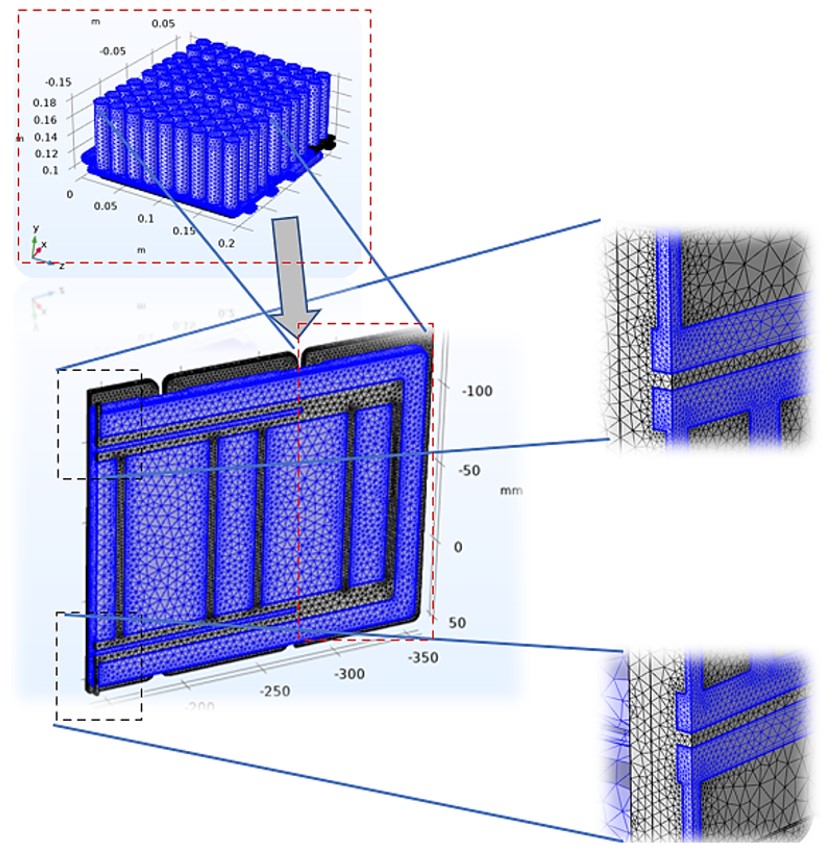Parametric Study on Water-Cooling Plates to Improve Cooling Performance on 18650 Li-ion Battery
Main Article Content
Abstract
With a novel NSTDA design, pressure drop, and standard deviation of cooling water velocity inside the channel of the liquid cooling plate were evaluated under various channel counts [2, 3, 4, and 6 channels per base], inlet temperatures of water [25, 30, 35, and 40 °C], and inlet velocity of water [0.5, 1.0, 2.0, and 3.0 m/s] at steady-state conditions. It was found that the 4-channel design produced the most distributed flow with an inlet water velocity of 0.5 m/s. The average channel velocity was 0.0371 m/s. When increasing the inlet velocity of water, a larger pressure drop was observed. Simulation of heat transfer on a single row, single cooling channel design of a battery pack was performed with a channel velocity of 0.03 m/s, which imitates the 4-channel design under the heat generation produced at a charging rate of 0.75 C. An inlet temperature of 30 °C was used to keep the maximum temperature of the battery at 30.706 °C. The temperature difference over the battery pack was approximately 0.4 °C.
Article Details

This work is licensed under a Creative Commons Attribution-NonCommercial-ShareAlike 4.0 International License.
This work is licensed under a Creative Commons Attribution-NonCommercial-ShareAlike 4.0 International License.
References
Greco A, Jiang X, Cao D. An investigation of lithium-ion battery thermal management using paraffin/porous-graphite-matrix composite. J Power Sources. 2015;278:50-68.
Azizi Y, Sadrameli SM. Thermal management of a LiFePO4 battery pack at high-temperature environment using a composite of phase change materials and aluminum wire mesh plates. Energy Convers Manag. 2016;128:294-302.
Lyu Y, Siddique ARM, Majid SH, Biglarbegian M, Gadsden SA, Mahmud S. Electric vehicle battery thermal management system with thermoelectric cooling. Energy Rep. 2019;5:822-827.
Chantheve P, Hirai S, Lailuck V, Laoonual Y, Sriam P, Rompho S, et al. A simplified approach for heat generation due to entropy change in cylindrical LCO Battery. 2018 IEEE Transportation Electrification Conference and Expo, Asia-Pacific; 2018 Jun 6-9; Bangkok, Thailand. USA: IEEE; 2018. p. 1-5.
Huang Y, Mei P, Lu Y, Huang R, Yu X, Chen Z, et al. A novel approach for Lithium-ion battery thermal management with streamline shape mini channel cooling plates. Appl Therm Eng. 2019;157:113623.
Qian Z, Li Y, Rao Z. Thermal performance of lithium-ion battery thermal management system by using mini-channel cooling. Energy Convers Manag. 2016;126:622-631.
Lan C, Xu J, Qiao Y, Ma Y. Thermal management for high power lithium-ion battery by mini channel aluminum tubes. Appl Therm Eng. 2016;101:284-292.
Yang XH, Tan SC, Liu J. Thermal management of Li-ion battery with liquid metal. Energy Convers Manag. 2016;117:577-585.
Saw LH, Ye Y, Tay AAO, Chong WT, Kuan SH, Yew MC. Computational fluid dynamic and thermal analysis of Lithium-ion battery pack with air cooling. Appl Energy. 2016;177:783-792.
Alipanah M, Li X. Numerical studies of lithium-ion battery thermal management systems using phase change materials and metal foams. Int J Heat Mass Transf. 2016;102:1159-1168.
Yan J, Wang Q, Li K, Sun J. Numerical study on the thermal performance of a composite board in battery thermal management system. Appl Therm Eng. 2016;106:131-140.
Wang H, Xu W, Ma L. Actively controlled thermal management of prismatic Li-ion cells under elevated temperatures. Int J Heat Mass Transf. 2016;102:315-322.
Lu Z, Meng XZ, Wei LC, Hu WY, Zhang LY, Jin LW. Thermal Management of densely packed EV battery with forced air-cooling strategies. Energy Procedia. 2016;88:682-688.
Bernardi D, Pawlikowski E, Newman J. A general energy balance for battery systems. J Electrochem Soc. 1985;132:5-12.
Paccha-Herrera E, Calderón-Muñoz WR, Orchard M, Jaramillo F, Medjaher K. Thermal modeling approaches for a LiCoO2 lithium-ion battery—a comparative study with experimental validation. Batteries. 2020;6(3):40.
Chen D, Jiang J, Kim GH, Yang C, Pesaran A. Comparison of different cooling methods for lithium-ion battery cells. Appl Therm Eng. 2016;94:846-854.
Ho VT, Chang K, Lee SW, Kim SH. Transient thermal analysis of a Li-ion battery module for electric cars based on various cooling fan arrangements. Energies. 2020;13(9):2387.
Xu X, Li W, Xu B, Qin J. Numerical study on a water-cooling system for prismatic LiFePO4 batteries at abused operating conditions. Appl Energy. 2019;250:404-412.
Barbir F. PEM fuel cells. In: Barbir F, editor. PEM Fuel Cells: Theory and Practice. Amsterdam: Elsevier; 2005. p. 33-72.
Incropera FP, DeWitt DP. Introduction to heat transfer. 2nd ed. Hoboken: Wiley; 1990.
Kulranut J, Depaiwa N, Yenwichai T, Intano W, Masomtob M. Improvement of estimation method for battery cell heat generation. J Res Appl Mech Eng. 2021;9(2):1-10.



